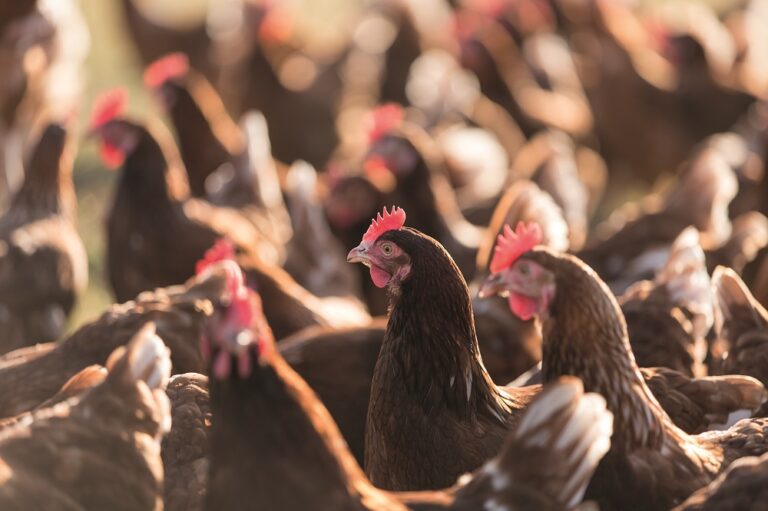Mycoplasma Gallisepticum in commercial layers is a costly problem. So what are the options?
By Matthew Balfour & Marie Menniti, St David’s Poultry Team
Mycoplasma gallisepticum (MG) is an intracellular bacteria responsible for significant economic losses within the UK commercial layer industry.
It is unusual in its complete lack of a cell wall, its ability to cause a persistent infection and its potential for both horizontal (i.e. bird to bird) and vertical (i.e. parent to chick via the egg) transmission.
MG infection within a flock of commercial layers typically results in a 10-20% reduction in egg production and a reduced feed conversion rate. However, it may also combine with other pathogens, for example respiratory viruses to cause respiratory disease.
Since MG has the ability to cause a persistent infection, the expression of clinical signs is often associated with periods of stress such as a change in feed ration, fluctuations in temperature, or a build-up of red mite.
Although the incidence of vertical transmission within the UK commercial layer industry is negligible, the incidence of horizontal transmission is high. This may involve bird to bird transmission within a flock or the transfer of disease from an infected to an uninfected flock – usually by a breach in biosecurity.
As a poultry veterinarians in Scotland, MG is a disease which we see frequently, particularly on multi-aged sites. Unfortunately, infection can be difficult to eliminate on a multi-age site due to its tendency to spread from older flocks to younger newly-placed flocks. Multi-age layer sites with on-site rearing sheds pose a particular challenge.
Diagnosis
The ‘gold-standard’ diagnostic test for MG is by culture, however this is expensive and time-consuming which limits its use in clinical practice. More frequently PCR testing is used. This test detects bacterial genetic material, usually from a tracheal or choanal cleft swab sample. It has the advantage of being quick, relatively inexpensive and is able to deliver a positive result in a bird which has become infected only very recently.
Alternatively, serological testing can be used to detect MG blood antibodies produced by the bird following infection. The two serological tests most commonly used in clinical practice are Rapid Serum Agglutination (RSA) and enzyme-linked immunosorbent assay (ELISA). RSA tests have the advantage of being able to detect antibodies faster than ELISA tests post-infection (in 5-7 days as opposed to 2-3 weeks) however they lack specificity and false positive reactions are frequent. Meanwhile ELISA tests have good sensitivity and specificity but fail to produce a positive result for 2-3 weeks post infection. Both tests are cheap, quick and therefore useful for routine flock monitoring of MG status.
Prevention is better than cure
As with all medicine, prevention is better than cure. Full implementation and adherence to the BEIC biosecurity requirements will dramatically reduce the risk of an MG incursion into an unexposed flock. A single age site set-up with thorough cleaning and disinfection between flocks is also a major advantage.
If a flock becomes infected with MG then antibiotic treatment is often required in order to suppress clinical signs. As MG does not have a cell wall, care must be taken not to select an antibiotic whose mode of action targets the bacterial cell wall and will therefore be ineffective. Tylvalosin and Aivlosin are both effective choices and have a zero withdraw period for eggs. However, it should be noted that antibiotic treatment will not eliminate MG infection and clinical signs will likely recur after several weeks.
Vaccination is an option for an unexposed flock due to enter a high-risk environment. Vaccines can be divided into live (Nobilis MG 6/85, TS-11) and killed (MG-Bac or autogenous). Live vaccines are produced by growing MG bacteria to be temperature-sensitive or modified in a way that does not cause clinical disease. Following administration, vaccine-strain MG colonises the upper respiratory tract and provides some local protection against infection by a wild-type MG. They may therefore, if used consistently and in certain circumstances, displace wild-MG from a site. Administration is strictly by eyedrop for TS-11 vaccine or by spray for Nobilis MG 6/85 vaccine.
Killed vaccines are created using particles of MG bacteria and administered by injection. An inoculated bird will mount a blood antibody response to these particles. Killed vaccines aim to reduce MG clinical signs and transmission levels rather than preventing infection in the first place.


